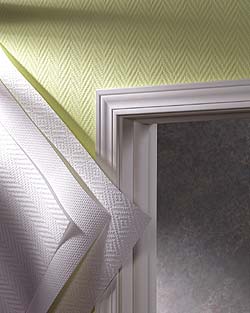
Wallpaper, Glass Textile
Wall Coverings
Wallpaper: Glass Textile Wall Coverings - Beautiful, durable, and versatile
by Denise Wendt
glass textile wallcoverings are quickly gaining popularity in the United States. Designed to be finished with a paint coating or decorative finish after installation, they combine the versatility of paint with the strength and durability of woven glass textile yarns made from sand, lime and clay. The yarns are woven into various textures and patterns, and then treated with a natural binder for stability during the hanging process.
Depending on the thickness of the paint application, heavier textures and patterns can be painted up to 10 times without losing texture. These wallcoverings have a long life cycle — 30 years or more — and can save thousands on redecorating. In addition, some paintables can actually reinforce wall surfaces, making them more durable than painted walls.
“Paintables expand the users’ decorating flexibility,” says Deborah Roos, vice president of Roos International Inc., a Deerfield Beach, Fla.-based company that specializes in glass textile wallcoverings. “They offer a variety of textures and patterns, and when combined with new faux finishes and metallic paints, applicators can create some exciting new looks.” Any level of gloss can be used with glass textiles.
Paintables can effectively camouflage problem surfaces and some imperfections. Glass textiles are much stronger than some vinyl-coated paper paintables and can actually help resurface or reinforce a wall and cover minor imperfections, reducing the amount of time and money spent on wall preparation.
“As with any wallcovering project, the walls must be structurally sound and they should be primed with a top-quality wallcovering primer,” recommends Joe Parker, owner of Precision Paperhanging in Chadds Ford, Pa., and president of the National Guild of Professional Paperhangers. “[Paintable wallcoverings] do hide multiple poor conditions, but the better the prep, the more satisfying the application.”
Chuck Hogan is a market development manager for Denver-based Johns Manville, which manufactures Tassoglas, Textra and Scandatex glass textile wallcoverings.
“For professional painters, glass textiles add integrity to their work,” says Hogan. “When a wall is reinforced with glass textiles, hairline cracks caused by house settling generally do not return. The paint professional can also use glass textiles to reface less than perfect drywall or other surfaces before painting.”
In addition to beauty and durability, glass textiles are flame-retardant and environmentally friendly. “Most existing paintables are paper or vinyl-based and have a much higher flame spread,” says Hogan.
When painted with a low-sheen latex paint, glass textiles are a breathable solution where mold and mildew are a concern.
“Vinyl doesn’t breathe and becomes a vapor barrier on the wall,” says Roos. “If moisture gets trapped under the wallcovering or inside the wall cavity, mold and mildew can start growing. Most consultants recommend avoiding vinyl in humid climates.”
“Paper breathes and so do glass textile wallcoverings,” adds Roos, “as long as they are painted with water-based latex paints.” She adds that some inexpensive paper products may not hold up as well in humid climates and can more readily water stain.
Glass textiles are also user-friendly. “Unlike other paintable wallcoverings, glass textiles do not expand and contract,” says Hogan. “This means the seams will not open or separate during or after hanging — a significant selling point for the consumer.”
Glass textiles come in wider rolls — almost 20 inches wider — than embossed papers or vinyls. “Wider rolls mean fewer strips, fewer seams and less work for both consumer and contractor,” says Hogan.
With minor preparation, glass textile wallcoverings can be easily installed over wood paneling, block, brick, stucco, plaster, tile and drywall. Basic prep varies depending on the condition of the surface and the desired look.
Glass textiles are installed by applying paste on the wall, avoiding the need to paste or wet the wallcovering directly. “This avoids the mess of trying to hang wet, prepasted strips associated with some other paintables,” says Hogan.
“Paintable glass textile wallcoverings are very easy to work with and don’t require double cutting,” says Roos. “The adhesive is applied to the wall surface and the cut lengths of wall covering are placed on the wall and smoothed with a plastic applicator. Then each length is butt-joined. Once the adhesive is dry, simply paint.”
Roos recommends using a 3⁄4-inch to 1-inch nap roller for adhesive and paint. Use a plastic smoother to smooth out the wallcovering on the wall. Use a paint brush to cut in adhesive along edges of wall surface and also to cut in edges of paint and primer on wallcovering. Use a sharp snap-off knife blade to cut and trim the glass textile wallcovering.
“Cleanability is mostly determined by the paint finish,” says Roos. Follow the paint manufacturer’s recommended cleaning guidelines.
“Prices for glass textile wallcoverings range from $3 dollars per yard to $20 dollars per yard,” Roos says. “The lower range would cover plain designs such as a burlap or basket weave. Priced a little higher and new in the glass textile offering are Phantasy Plus jacquard weaves, available from Vitrulan Corp., offering innovative new designs, custom design capabilities and custom logos.”
Pricing depends on the complexity of the design and the weight of the yarn needed to make the design.
Lower maintenance costs associated with glass textiles should be figured into the bottom line of any job. In addition, there are typically lower repair and prep costs associated with glass textiles.
Paintable wallcoverings require no more maintenance than any painted wall requires, says Parker. “If they have an enamel finish, they will clean up wonderfully,” he says. “Properly installed, they will last for years.”

|

